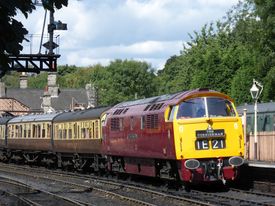BR Class 52 D1015 Western Champion
| BR Class 52 D1015 Western Champion | |
|---|---|
 D1015 Western Champion at Bridgnorth in August 2016 | |
| Built By | BR Swindon Works |
| Configuration | C-C |
| Power type | Diesel Hydraulic |
| Status | Operational |
| Loco Number | D1015 |
| History | |
| Built | 1963 |
| Designed By | British Railways |
| Type | Class 52 |
| 1980 | Purchased by DTG |
| 2002 | Main line certified |
| Technical | |
| Length | 68ft |
| Weight | 108t |
D1015 Western Champion is a BR Class 52 ‘Western’ diesel-hydraulic locomotive, owned by the Diesel Traction Group (DTG). The locomotive visited the railway on various occasions for diesel galas and for attention by the DTG’s engineering staff. From 2015 onwards the locomotive has remained at the SVR for extended periods of time, and from 2017 is regarded as a resident locomotive.[1]
Contents
D1015 in service
D1015 Western Champion was built at BR’s Swindon works and entered service at Cardiff Canton in January 1963. Other allocations included London Old Oak Common, Swansea Landore and Plymouth Laira, where the locomotive was withdrawn by BR on 13 December 1976 after accumulating 1,296,000 miles in service.[2]
D1015 in preservation
In 1980 D1015 became the third locomotive to be acquired by the DTG, which already owned SVR residents D821 Greyhound and Hymek D7029.[3] D1015 achieved main line certification in 2002, since which it has hauled over 60 rail tours as far as Penzance in the south and Kyle of Lochalsh in the north.[4]
In 2002 and 2015 D1015 attended the diesel galas and in 2016 D1015 attended both the May diesel gala and the August ‘Western Weekend’. By December 2016 the DTG had entered into a running agreement with the SVR, when the locomotive returned following an issue experienced with the B engine during The Canterbury Champion rail tour.[5] In January 2017 the DTG announced that the engine needed to be replaced before D1015 could commit to further mainline running and an appeal for £50,000 was launched, which was rapidly filled and the share offer closed the following month.[6] The loco operated on one engine while two engines are rebuilt in parallel, one by DTG engineers at Kidderminster and one on their behalf in Germany. In August 2019 the locomotive moved to the Diesel Depot for a replacement engine to be fitted.
The picture below shows the locomotive still carrying the identity of D1031 Western Rifleman which was used during the rail tour.
See also
Diesel Locomotives
Diesel Locomotives visiting the SVR for galas
Locomotives running under different identities
References
- ↑ SVR Spring Diesel Festival 2017 Brochure, which listed D1015 under "Home Fleet"
- ↑ BR Database
- ↑ westernchampion.co.uk About Us
- ↑ D1015 Western Champion Railtour Archive
- ↑ Canterbury Champion railtour
- ↑ DTG website announcement (retrieved 6 January 2017)
Links
DTG website westernchampion.co.uk
British Rail Class 52 on Wikipedia
| ||||||||||||||||||||||||||||||||||||||||||||||||||||||||||||||||||||||||


